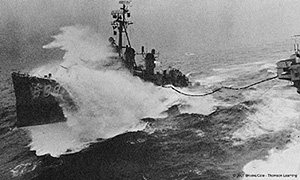Picture created by author with Photoshop 4.0.1 – 7/23/97
Ocean Moods – Aboard the USS Lyman K Swenson (DD-729)
Ernest Knowles, Captain, USNR (Retired)
 Written at sea on February 13, 1962 while a LTJG, USN aboard the USS Lyman K. Swenson (DD-729), after a particularly violent storm in the North Pacific. The picture shown on the right is of a slightly smaller destroyer than mine, but the conditions shown were similar to those we experienced. Also shown in this included video, are larger ships in conditions much like we experienced (note how the aircraft carrier is barely moving, but how the cruiser’s bow is breaking waves) – skip whatever ads show up, as soon as you can, to get to the video itself.
Written at sea on February 13, 1962 while a LTJG, USN aboard the USS Lyman K. Swenson (DD-729), after a particularly violent storm in the North Pacific. The picture shown on the right is of a slightly smaller destroyer than mine, but the conditions shown were similar to those we experienced. Also shown in this included video, are larger ships in conditions much like we experienced (note how the aircraft carrier is barely moving, but how the cruiser’s bow is breaking waves) – skip whatever ads show up, as soon as you can, to get to the video itself.
A side-note about this writing. In 1963, as a young LTJG in the Navy, I was used to such storms and often wondered:
- (1) Why could we find submarines at longer distances in the middle of the Pacific Ocean, but not off the California Coast;
- (2) Why did ocean waves built up so quickly in the Taiwan Straits compared to the deep middle of the Pacific Ocean;
- (3) Why would my destroyer’s bow-wake, in the calm seas of the Pacific Ocean, be filled with a wonderfully beautiful bioluminescence;
- (4) Why in the Sonar “Shack” could I hear the moans and clicks of whales at very long distances away; and
- (5) Why did we often sailed through well organized and parallel crest-lines of waves (“swell”) in a windless open ocean, but other times through very chaotic and unorganized “seas” in the middle of storms.
I had, at the time, no thought of studying oceanography, but just a few years later, I left active duty in the Navy and entered graduate school at Texas A&M University, and after 5 years, earned MS and PhD degrees in Physical Oceanography. During my graduate study, and in the 50 years that I have taught undergraduate and graduate oceanography courses at North Carolina State University, I have learned the answers to all of those questions and to many more, and with a great joyous passion, have taught the science of the ocean to anyone who was willing to learn.
![]()
When speaking or writing about the sea, one has at his fingertips many sources of ideas and information from which to draw. Literally thousands of volumes, both scientific and poetic, have been written and compiled by those who, through their own experiences and emotions, know the intricacies and kaleidoscopic moods of this vast medium. The large portion of these writings are poetic rather than scientific, because the ocean is so vast and we know so little about the processes that change its surface, and even less about what is in its depths. Even more than the conquest of space, the seas are the world’s last great frontier.
![]()
The intricacies of the sea one can leave to the scientist.
But what of the sea’s many complicated, often humanlike, awe-inspiring, and sometimes terrifying moods?
Who lives for them and who dies because of them?
Who feels them?
The poet? — Certainly!
The sailor? — if he loves the sea!
The fisherman? — of course, though he may never write of it!
And what of the romantic adventurous young and the humble dreaming old?
Certainly, but aren’t we all a bit of each?
![]()
The sea has calmness, a serene limpid calmness that rests and fondles and lulls us into a feeling of benevolent peace.
A splendid calmness full of rainbow-accentuated colors from the lightest azure blues to the deepest vibrant reds,
that fills our spirit but can never satiate it.
The sea also has violence, terrible violence locked within its vastness, with power so terrific, energy so abundant, and fury so wantonly destructive,
that we defy it at our own peril.
The sea is like a woman some say, loving, warm, tender, comforting, sensually and spiritually exciting,
but also unpredictable, uncontrollable, jealous, wrathful and vindictive.
![]()
It can be all or none of these. Who knows what mood the sea may take next?
The sailor? — no, though from experience he may make predictions, but they really are only guesses.
Today, he may guess a quiet mood, but on the morrow find one quite different.
But why should the sailor worry what mood the morrow brings?
IS HE AFRAID?
![]()
The bravest of sailors remembers his sea in many moods, but none so well as when it is angry.
He has sailed his ship through many storms, yet always fears the next the most!
The uncertainty and fear of the unknown,
and the feeling that maybe this time the devil himself will have his way, and cause the seas to rise up and crush him like grain upon a grinding stone,
makes him humble and one with the sea.
He remembers how the wind can whip up the sea until mountainous waves tower far above him.
He’s seen the sky blacken, as if the sun were suddenly thrust into a dark and bottomless pit.
He’s felt the driving, piercing rain pound his face and freeze his cheeks and numb his hands.
He’s felt his ship be lifted up, and seen it tossed and twisted and heard its agonizing groan,
then rode its pitching decks down again as it slammed hard into the oncoming sea.
His muscles tense and knuckles white, he’s gripped the rail
and braced himself against the thrust he knew would come.
He’s heard the seas pound his ship and felt it shudder as the bow crashed under the next gigantic fortress.
He’s seen the foaming black-green cataract roar down its decks,
ripping canvas, bending stanchions, crushing vents and snapping lines.
He remembers praying that the engines would not fail him,
that the power of the screws, always turning, always straining, always pushing,
Would force the dented bow ever onward, over and through,
until it at last broke free from the sea, to be lifted, twisted and hurled down again!
![]()
More than being afraid, the sailor has learned to RESPECT the ocean.
He’s also an adventurer and a romanticist and a poet, who sees and hears and feels the beauty that is always present,
even at the height of the storm,
even as he curses loudly at his contemptuous, compunctious, uncompromising enemy,
even in its most fearsome form.
Because he also has great faith that on the morrow, the SUN WILL SURELY RISE!
![]()

